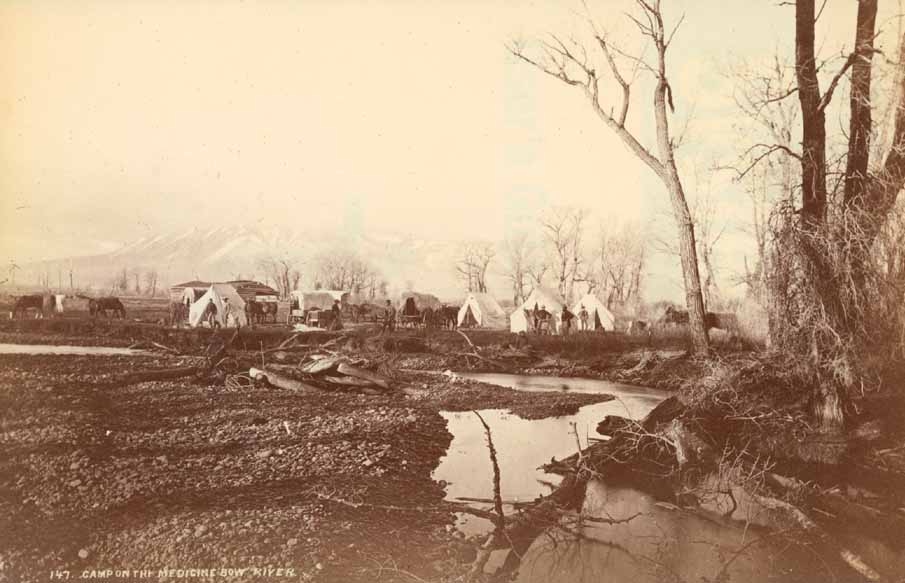
Camp Along Medicine Bow River, Hayden Expedition 1871, photo by Wm. H. Jackson
The Union Pacific reached Medicine Bow in 1868, when the town consisted of little more
than a store and saloon. As indicated in the discussion of William Henry Jackson on
Photos IV, Jackson in 1869 followed the
Railroad from town to town across the Territory. Thus, he had visited the area before
his joining of the Hayden expedition pictured above.
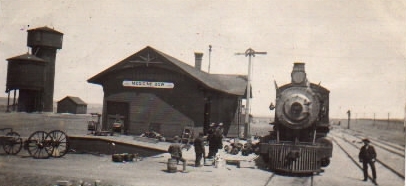
Medicine Bow, 1907The Depot pictured
burned in 1913 and was replaced by the present depot, erected in November,
1913, which now houses a museum.
By 1876, the first school was established. With
the cattle boom of the late 1870's and early 1880's, Medicine Bow became the
largest cattle shipping point on the UPRR, shipping an average of 2,000 head
a day
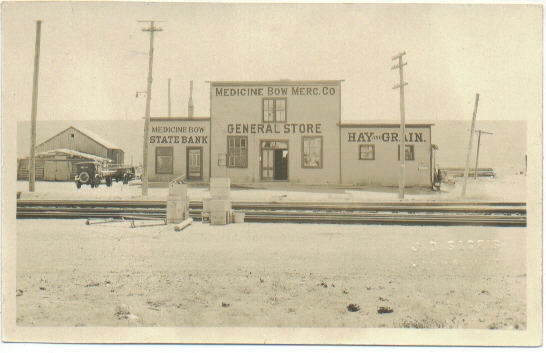
Medicine Bow, 1920's, photo by J. D. Sagris.
At the time of the above photo, Medicine Bow had
two banks, two hotels, two garages and a population of approximately 300.
Medicine Bow, today takes pride as the location of many a scene in Owen Wister's
The Virginian, Horseman of the Plains. The two hotels take their name from Wister's
novel. One is named the Virginian and the other, the Trampas Lodge, after the Virginian's
foe.
Wister, photo below right, in Chapter 2, introduces the reader to Medicine Bow:
Medicine Bow was my first, and I took its dimensions, twenty-nine buildings in all,--one coal shute,
one water tank, the station, one store, two eating-houses, one billiard hall,
two tool-houses, one feed stable, and twelve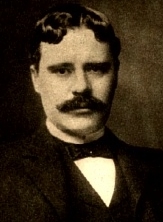 others that for one reason and
another I shall not name Yet this wretched husk of squalor spent thought upon appearances;
many houses in it wore a false front to seem as if they were two stories high.
There they stood, rearing their pitiful masquerade amid a fringe of old
tin cans, while at their very doors began a world of crystal light, a land
without end, a space across which Noah and Adam might come straight from Genesis.
Into that space went wandering a road, over a hill and down out of sight, and up again
smaller in the distance, and down once more, and up once more, straining
the eyes, and so away.
others that for one reason and
another I shall not name Yet this wretched husk of squalor spent thought upon appearances;
many houses in it wore a false front to seem as if they were two stories high.
There they stood, rearing their pitiful masquerade amid a fringe of old
tin cans, while at their very doors began a world of crystal light, a land
without end, a space across which Noah and Adam might come straight from Genesis.
Into that space went wandering a road, over a hill and down out of sight, and up again
smaller in the distance, and down once more, and up once more, straining
the eyes, and so away.
Wister shows the same inventory in his diary for July, 1885, however, omitting in the above
references to the ladies and gents "walks" where standing on the seat was not a luxury but a
necessity. Perhaps, Wister's jaded view of Medicine Bow was influenced by his having
to sleep on the counter in the store, a scene which he also used in the novel:
July 21st
I slept from ten to twelve thirty on the counter of the store at Medicine Bow
and then the train came in bringing the lawyer and the fish--and
after much business talk and lifting tin cans we started off across the
plains at two o'clock....
Indeed, however, judging from Arthur Rothstein's 1940 photo of Medicine Bow immediately below, by
the middle of the following century things had hardly changed.
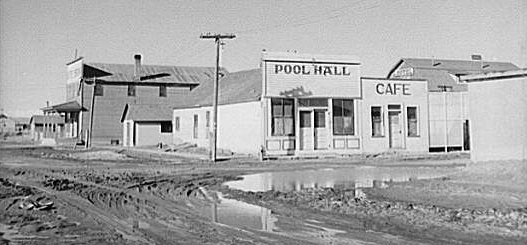 Medicine Bow, March, 1940, photo by Arthur Rothstein
Medicine Bow, March, 1940, photo by Arthur Rothstein
Arthur Rothstein (1914-1985) was a photographer for the
Federal Resettlement Administration, later the Farm Security Administration,
from 1935 until 1940. He was most famous for his depiction of the Oklahoma
Dust Bowl with his 1936 Fleeing a Dust Storm depicting a farmer and his
two sons in front of a shack in an Oklahoma dust storm. The photo the following
year was featured in the Metropolitan Museum of Modern Art. Some controversy,
however, developed over at least one photo in which he was accused of making
conditions appear worse than they really were in order to assist with New Deal Legislation.
In the particular instance he moved a cow skull ten feet. For the remainder of
his life he regretted the photo.
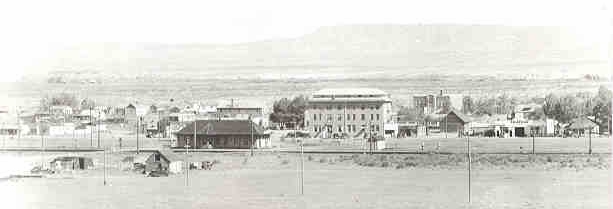
Medicine Bow, 1930's
The Virginian Hotel is in center, fronting on the
Lincoln Highway. The Hotel was built by August Grimm, first mayor of Medicine Bow, and his
partner George Plummer and opened on September 30, 1911. The hotel featured
the first electric lights and sewer system in the town.
The railroad depot, toward the viewer, was, as above noted, built in 1913
and now houses a museum.
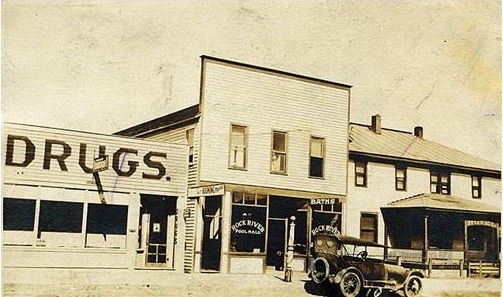
Rock River, 1921
To the left is Miller's Drug Store, in center is
the Rock River Pool Hall also providing baths, and to right is the hotel. The Town
of Rock River is on Rock Creek. The seperate town of Rock Creek was originally
a terminus of the stage route to Junction City Montana. The Railroad moved
the train stop to Rock River and Rock Creek faded away.
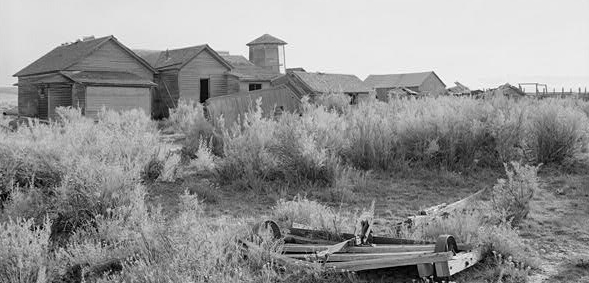
Rock Creek Station
The stage station at Rock Creek was constructed in 1860, and was destroyed, as
noted in the discussion of the Deadwood Trail, by Indians.
The town, itself, was founded
in 1867. The railroad reached it in 1878 and the town became an important junction
for freighters and stages heading north. The stage trip to Custer City took
three days. At one time the town had 5 saloons, 2 hotels,
the railroad depot, post office, the stage station and two mercantile establishments,
of which the clerk in one, Clay's Store, was lynched in 1882 by freighters and cowboys after
he murdered a customer. The Town's plat was relinquished in 1904.
Rock Creek is noted as being the location of one of
the worst disasters in the history of Wyoming.
In October 1856, over 200 handcart pioneers perished when caught by an
October blizzard. The station was originally constructed in 1860 and destroyed
by Indians several times. Also, it was near Rock Creek, that Indians attacked the Fletcher Family, killing the mother, wounding
the father and son and abducting the two daughters, Mary, 17, and Lizzie, 2. Mary
was rescued by trappers several days later, but nothing was heard of Lizzie
until 30 years later, when in Casper it was noticed that an Indian woman
was really white. She spoke no English and refused reunion with her sister and
instead, lived out her life on the Wind River Reservation.
|